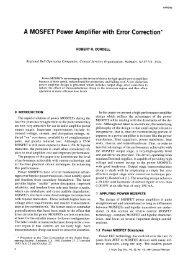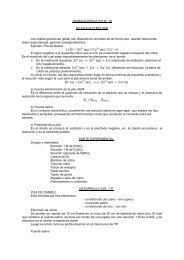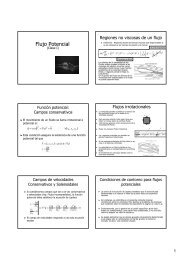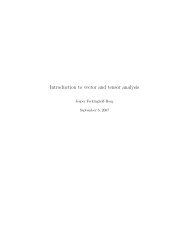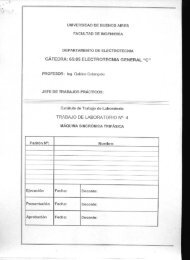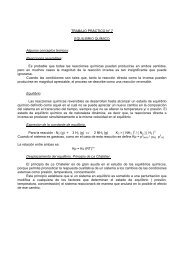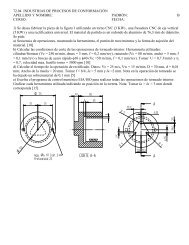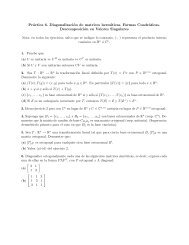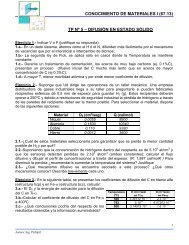Download PDF
Download PDF
Download PDF
Create successful ePaper yourself
Turn your PDF publications into a flip-book with our unique Google optimized e-Paper software.
EMF and health<br />
design and quality, do not. The comparative<br />
analysis by Kheifets (76) points out how susceptible<br />
study findings are to subtleties of statistical<br />
methods and to random error.<br />
Without a formal meta-analysis, the results in<br />
Table 2 are likely to be consistent with a small<br />
gradient of increasing risk with increasing<br />
exposure that varies largely by chance across<br />
studies. Although individual studies may suggest<br />
that a stronger effect is found for electric<br />
fields (75), for specific subtypes of leukemia<br />
(71), or in conjunction with residential exposures<br />
(110), replication is required to draw<br />
conclusions about such patterns.<br />
REVIEW OF RESIDENTIAL STUDIES. The<br />
effect of exposure from transmission lines has<br />
been studied in four case–control studies<br />
(57,59,113,114). No information, however,<br />
was collected in those studies either on other<br />
sources of residential exposures [except by<br />
Severson et al. (57)], or on occupational<br />
exposures [except by Feychting et al. (110)].<br />
This may have resulted in substantial exposure<br />
misclassification. A small increased risk<br />
for all leukemia was seen in only one (113) of<br />
the four studies, in association with calculated<br />
magnetic fields of more than 0.1 µT in the<br />
year preceding diagnosis. Results of analyses<br />
of specific subtypes of leukemia are inconsistent<br />
across studies and difficult to interpret<br />
because of small numbers of exposed cases.<br />
An increased risk was seen for AML and<br />
CML but not for CLL in the Swedish study<br />
(59). The odds ratio for AML was reduced,<br />
however, and the risk of CML disappeared<br />
when analyses were restricted to subjects with<br />
no or very little occupational exposure,<br />
whereas the odds ratio for subjects with both<br />
high occupational and residential exposures<br />
increased (6.3, 95% CI 1.5–27 for both AML<br />
and CML, based on only 3 exposed cases). In<br />
the Finnish study, a significant increase was<br />
seen for CLL only, for exposures over 10<br />
years before diagnosis and for durations of<br />
exposures of 12 years or more, based on 3<br />
exposed cases (114).<br />
The risk of leukemia from the use of electric<br />
appliances was considered in two<br />
case–control studies (57,115–117). Neither<br />
of these studies provides information about<br />
such risk, however, because of limitations of<br />
study design and exposure assessment.<br />
CONCLUSIONS. The research on the risk<br />
of adult leukemia in relation to occupational<br />
and residential magnetic field exposure<br />
includes a number of large studies of varying<br />
quality, with the most research by far addressing<br />
occupational exposures. Some of these<br />
studies are excellent (7,71,73,106,110);<br />
applying sophisticated epidemiologic methods<br />
to the evaluation of the role of magnetic<br />
fields, though a few studies have attempted to<br />
address electric fields as well. Results from<br />
these studies have ranged from null to rather<br />
strong positive associations, with relative risks<br />
in the upper exposure categories above 2.0.<br />
Unfortunately, there is not a clear pattern in<br />
which the better studies are more or less likely<br />
to produce positive associations. In the aggregate,<br />
assuming random error accounts for differences<br />
among studies, the results are most<br />
consistent with a weak positive association,<br />
with relative risks for the more highly exposed<br />
groups of the order of 1.1–1.3. Relative risks<br />
of this magnitude are below the level at which<br />
epidemiologic methods can effectively assess<br />
causal relations. Nevertheless, the evidence at<br />
present supporting a role for EMF in the etiology<br />
of adult leukemia is weak. The standards<br />
for future epidemiologic studies to<br />
make a notable difference in the totality of<br />
evidence are extremely high. An exceptional<br />
opportunity to study very large populations<br />
with well-characterized, relatively high exposure<br />
and detailed cancer incidence data would<br />
be required to provide a significant advancement<br />
in our knowledge on this topic.<br />
Nervous system tumors. REVIEW OF OCCU-<br />
PATIONAL STUDIES. Completely analogous to<br />
the literature on electric occupations and<br />
leukemia, there is a sizeable literature on electric<br />
occupations and brain cancer. Interest in<br />
brain cancer as a potential consequence of<br />
EMF exposure began slightly later than the<br />
interest in leukemia, with an influential paper<br />
by Lin et al. (118) linking electric occupations<br />
to brain cancer using death certificate<br />
data. At the time of the meta-analysis by<br />
Kheifets et al. (102), 29 relevant reports had<br />
been published, most of which assessed exposure<br />
on the basis of job title alone. Most<br />
studies tended to show a small increase in risk<br />
of brain cancer among electric workers, with<br />
a pooled relative risk estimate of 1.2. Some<br />
studies showed no association, and the risk<br />
estimates were highly imprecise in many<br />
studies, reflecting the rarity of brain cancer.<br />
The association was stronger for studies that<br />
presented results restricted to gliomas (RR =<br />
1.4) and was stronger for electrical engineers<br />
(RR = 1.7) but similar across the other specific<br />
occupational categories. There was no<br />
tendency either for jobs thought to have<br />
higher exposure or for studies with more<br />
sophisticated exposure assessments to show<br />
stronger associations. The pooling effort<br />
described above in which results from utility<br />
worker studies in France, Canada, and the<br />
United States were combined yielded an estimated<br />
relative risk of 1.12 per 10 µT-years<br />
(95% CI = 0.98–1.28), virtually identical to<br />
that found for leukemia (104). Once again,<br />
what appeared to be heterogeneity across<br />
studies was compatible with random variation<br />
around a common small effect.<br />
Ten studies that provided risk estimates<br />
for electric or magnetic fields using measurement-based<br />
job-exposure matrices and brain<br />
cancer are summarized in Table 2. Not<br />
surprisingly, the study findings are mixed,<br />
with suggestions of positive associations in<br />
five (71,73,106,111,119) and the remainder<br />
showing no indication of an association. Even<br />
among the studies designated as positive,<br />
there were rarely monotonic dose–response<br />
gradients and the largest relative risk estimates<br />
rarely exceeded 2.0. No pattern could be<br />
identified on the basis of the type of study<br />
population (electric utility, general population).<br />
Too few studies presented results for<br />
histologic subtypes of brain cancer to draw<br />
conclusions about heterogeneity of risk. The<br />
evidence at present for supporting a role for<br />
EMF in the etiology of brain cancer is weak.<br />
Results are most compatible with a small<br />
association, with some studies finding no<br />
association and some finding a stronger effect.<br />
There are insufficient data to identify particular<br />
exposure sources or patterns or disease<br />
subtypes associated with larger relative risks.<br />
REVIEW OF RESIDENTIAL STUDIES. The<br />
studies of residential exposures, once again,<br />
provide little additional information. Four<br />
studies have considered the risk of brain and<br />
CNS tumors in relation to residential exposures<br />
from high voltage transmission lines<br />
(58,59,113,120,121). No clear association<br />
was seen in any of these studies. Occupational<br />
exposure was taken into account in one study<br />
(110) but did not affect the results. None of<br />
these studies collected information on other<br />
sources of residential exposure.<br />
CONCLUSIONS. The conclusions provided<br />
for EMF and adult leukemia are essentially<br />
applicable to the brain cancer literature as<br />
well. A large number of studies, mostly<br />
addressing occupational exposure, have generated<br />
measures of association ranging from<br />
null to rather strongly positive, but in the<br />
aggregate, relative risk estimates would be in<br />
the range of 1.1–1.3, a level at which a meaningful<br />
discussion of causality is not possible.<br />
Breast cancer. REVIEW OF OCCUPATIONAL<br />
STUDIES. An interest in breast cancer as a possible<br />
consequence of electric and magnetic<br />
field exposure arose largely from a hypothesized<br />
mechanism proposed by Stevens and coworkers<br />
(100,101). It was hypothesized that<br />
electric and magnetic fields suppress the production<br />
of nighttime melatonin, analogous to<br />
light exposure at night, and that reduction in<br />
melatonin increases the risk of developing<br />
breast cancer. Over the past decade a fairly<br />
sizable body of research has addressed the<br />
influence of EMF on melatonin production.<br />
The question of an effect of EMF on melatonin<br />
lends itself to both human experimental<br />
studies (122) and observational studies of<br />
humans outside the laboratory. The literature<br />
from human experimental studies is generally<br />
negative regarding an effect of nighttime<br />
EMF on melatonin production (123–125).<br />
Environmental Health Perspectives • VOLUME 109 | SUPPLEMENT 6 | December 2001 923



